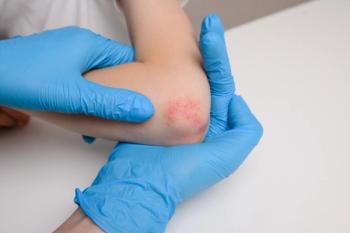
- Drug Topics September 2023
- Volume 167
- Issue 08
Gut Health Has Impact on the Skin
The gut-brain-skin axis is more important to overall health than previously understood, and prebiotics and probiotics play a large role in the benefits.
Literature and marketing about the body’s microbiome and gut health have become popular topics among our health-conscious patients. As a result, the discussion of prebiotics and probiotics and their significant role in maintaining gut health has gained popularity in recent years.
Although the research is in its infancy, it continues to point toward the gut-brain-skin connection. Additional data suggest that how much of what we eat or the supplements we take can affect our skin health—which leads us to explore the world of prebiotics and probiotics, and how they affect gut health to help us absorb these nutrients. This opens the door to the gut-skin axis and how it can affect our skin regarding inflammatory response diseases such as eczema, psoriasis, vitiligo, and acne.
Why Is the Microbiome Important?
The gastrointestinal tract contains microorganisms such as bacteria, viruses, and protozoa. Collectively, such microorganisms make up what is termed the gut microbiota, microbiome, or intestinal microflora. Their makeup and activity can play a significant role in health and disease.1
The balance of the microbiome on the skin and in our gut is an essential front line of defense, protecting us from germs. A good equilibrium helps break down food, releasing energy and vitamins to keep the body healthy. Since the body must coexist with the microbiome, it plays a crucial role in keeping our skin healthy. However, the body is exposed to daily external factors that can disrupt the homogeneous environment for optimal health. For example, disruptions from such causes as processed foods, antibiotics, stress, infection, disease, and exogenous organisms can drastically change the composition and activity of the gut microbiota.2
The microbiome’s balance and effect on the skin were initially introduced in 2016. Recent research and literature reviews point to a solid relationship between the gut-brain-skin axis and the gut microbiome balance vital to maintaining health and optimal immunity.3 We are discovering the importance of having a balanced gut microbiome and how any imbalance can lead to increased risk of inflammatory responses that can exacerbate acne, psoriasis, atopic dermatitis, urticaria, and vitiligo. In addition, a chronic unhealthy mix of microorganisms can lead to leaky gut syndrome, weakening the intestinal wall—an issue already linked to asthma and eczema.4
How Can We Feed Our Gut Microbiome?
The American diet has changed drastically since the introduction of processed foods. Adding a prebiotic and a probiotic can assist in creating a homogeneous environment of microorganisms in the gut. Breaking down the benefits of each aids understanding of why taking both is much more beneficial than taking either by itself.
Prebiotics
The fermentation process in the gut is important; prebiotics act as a primary carbon source in this metabolic process and the growth of beneficial bacteria such as bifidobacteria and lactobacilli. Overall, the health benefits of prebiotic dietary fibers can affect gut barrier permeability, decrease pathogenic bacteria populations and allergy risks, increase calcium absorption, and improve immune system defense.2
Examples include nondigestible specialized plant fibers such as spirulina, fructans, galacto-oligosaccharides, pectin, resistant starch, and rhamnose. They naturally exist in different dietary food products, including asparagus, sugar beet, garlic, chicory, onion, Jerusalem artichoke (Helianthus tuberosus), wheat, honey, banana, barley, tomato, rye, soybean, human and cow milk, peas, beans, and, recently, seaweeds and microalgae.5
Research has found that the oral administration of microalgae can modulate the gut microbiota, activate the immune system in the gut, and have powerful anti-inflammatory benefits.6 Generally, prebiotics play an essential role in human health and are found to be safe.
Probiotics
Live beneficial bacteria make up the definition of probiotics and are known to improve digestive health. The primary purpose is to “replace” the beneficial bacteria in the gut that a variety of factors, such as oral antibiotics, stress, and inflammation, can deplete.
Familiar probiotic foods include yogurt, kefir, sauerkraut, kombucha, pickles, sourdough, and miso. However, many more exist and are now widespread in supplement form, which may confuse the individual because certain strains of these supplements may do more harm than good. Knowing what strain is best for the condition is essential and the strain must have been shown to be effective in clinical trials. The most common are Lactobacillus and Bifidobacterium, but specific strains for treating certain conditions, such as acne, include Lactobacillus rhamnosus SP1. Other strains in the 7 core genera of microbial organisms include Saccharomyces, Streptococcus, Enterococcus, Escherichia, and Bacillus.1
Probiotics can be helpful as they are known to help digest food and fight off pathogens. In addition, clinical trials have shown probiotics to be beneficial in preventing allergies in children and atopic dermatitis. Probiotics differ from prebiotics because they contain live organisms and may need special storage. But, overall, they are found to be safe.
Final Microbiome Thoughts
Many patients are more conscious about their diet, which supports their gut and digestive health. As clinicians, we are at the front line of this discussion regarding skin health. Research shows that a healthy balance of gut microbiota is required for optimal skin health, creating metabolic and immune homeostasis. More research points to how compositional gut microbiota changes have been linked with exacerbating inflammatory skin diseases such as eczema, psoriasis, and more. Daily prebiotics and probiotics help keep a homogenous microorganism environment for optimal skin health.
References
1. Probiotics fact sheet for health professionals. National Institutes of Health Office of Dietary Supplements. Updated June 2, 2022. Accessed April 10, 2023. https://ods.od.nih.gov/factsheets/Probiotics- HealthProfessional/
2. Carlson JL, Erickson JM, Lloyd BB, Slavin JL. Health effects and sources of prebiotic dietary fiber. Curr Dev Nutr. 2018;2(3):nzy005. doi:10.1093/cdn/nzy005
3. Widhiati S, Purnomosari D, Wibawa T, Soebono H. The role of gut microbiome in inflammatory skin disorders: a systematic review. Dermatol Reports. 2021;14(1):9188. doi:10.4081/dr.2022.9188
4. Fermented foods can add depth to your diet. Harvard Health Publishing: Harvard Medical School. April 19, 2021. Accessed April 10, 2023. https://www.health.harvard.edu/staying-healthy/fermented-foods-can-add-depth-to-your-diet
5. Davani-Davari D, Negahdaripour M, Karimzadeh I, et al. Prebiotics: definition, types, sources, mechanisms, and clinical applications. Foods. 2019;8(3):92. doi:10.3390/foods8030092
6. Neyrinck AM, Taminiau B, Walgrave H, et al. Spirulina protects against hepatic inflammation in aging: an effect related to the modulation of the gut microbiota? Nutrients. 2017;9(6):633. doi:10.3390/nu9060633
Articles in this issue
about 2 years ago
The Role of Complementary and Alternative Medicine in Pharmacyabout 2 years ago
Assessing and Treating Opioid Use Disorder in Pregnancyabout 2 years ago
Dance With the Girl That Brung Yaabout 2 years ago
Review of FDA Approvals for Pediatric Obesity Managementabout 2 years ago
Biologics Offer Great Results in Treating Psoriasis—At a Costover 2 years ago
In A Post-Dobbs World, Pharmacists Still Face Uncertaintyover 2 years ago
How AI Can Improve Controlled Substance SecurityNewsletter
Pharmacy practice is always changing. Stay ahead of the curve with the Drug Topics newsletter and get the latest drug information, industry trends, and patient care tips.

















































































































